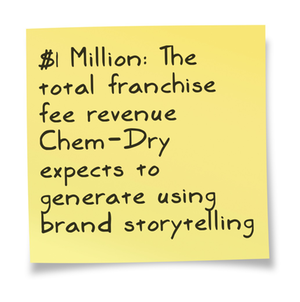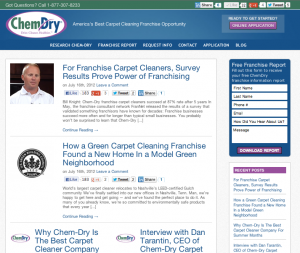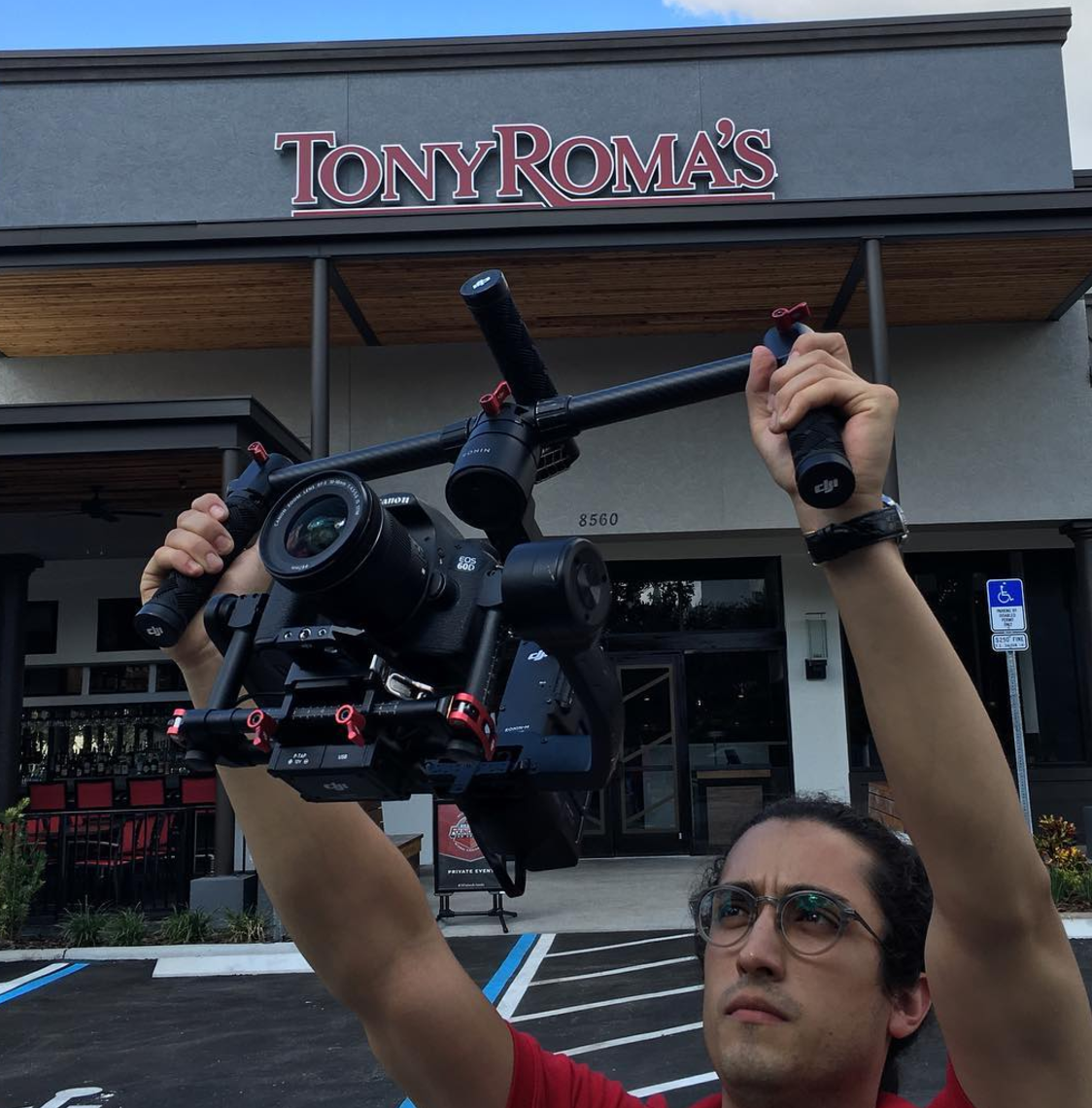5 Reasons We Like the Chem-Dry Carpet Cleaning Franchise
Focus on healthy products, professional service, first-rate training keep Chem-Dry on top – one of our top picks for anyone thinking about opening a new business
Chem-Dry isn’t just the world’s biggest carpet cleaning franchise, with more than 4,200 units in 47 countries. In our opinion, it’s the best carpet cleaning franchise and one of the best options for someone thinking about opening a new business.
Ever used Chem-Dry as a customer? We use it on our personal homes. No fly-by-night types allowed at Chem-Dry. You get sharp, professional cleaners, best-in-class equipment and a proven process that makes your carpet and home cleaner and healthier.
That’s not just our opinion. For 24 straight years, the company made Entrepreneur magazine’s prestigious Franchise 500 list of the top-rated franchises, and this year, once again, we ranked first among all carpet cleaning franchises. The company’s market share is 8 percent, the largest for a single brand in the highly fragmented carpet cleaning industry.
So what makes Chem-Dry the best carpet cleaning franchise? The company has been around for 35 years, and getting to the mountaintop hasn’t been easy — or an accident. It’s the result of hard work, forethought, trial and error, and commitment to being better than everyone else and as good as we can be. Here are our reasons to research Chem-Dry:
The Process
Chem-Dry was conceived in the mid-1970s, when the founder, Robert Harris, spilled some salad dressing on his tie during a flight and watched in amazement as a flight attendant cleaned the stain with an intriguing substance: club soda. From that moment, they have been committed to cleaning with carbonated water, a substance with great natural cleaning properties. Their competitors are steam cleaners, who dump massive amounts of hot water onto carpet, then suck it up with high-pressure vacuums. The suction can damage the carpet. Even if it doesn’t, the water can soak the carpet and backing, taking days to dry and creating a fertile environment for mold and mildew. Chem-Dry’s hot carbonated water extraction process uses a fifth of the water, resulting in a quicker, drier, healthier clean.
The Natural
That’s the name of Chem-Dry’s patented cleaning solution, which at base is a very simple liquid — carbon dioxide and water. They call it The Natural for a reason. It’s safe enough to drink (and they do, downing shots of The Natural during their annual conference). It’s free of any harmful chemicals or soaps, which means it won’t aggravate allergies, irritate mucus membranes or pose a risk to children, pets or you. What’s the use of a carpet you can’t roll around on? Robert Harris vowed from the beginning that Chem-Dry would use only environmentally safe products — the “Chem” is short for chemistry, not chemicals — and The Natural is the staple. Even though it’s harmless to animals, it’s murder on dirt. The carbonation acts like artillery at the molecular level, blasting dirt and oil from fiber surfaces like nothing else can.
The People
Carpet cleaners get a bad rap. Individual and mom-and-pop vendors with, shall we say, highly uneven skill and trustworthiness levels jockey for business and usually do jobs the quick and dirty (emphasis on dirty) way. Their vehicles are usually old, cluttered and filthy. Often, the cleaners themselves are…old, cluttered and filthy. Some drink. People who hire Chem-Dry get prompt service from polite, organized professionals in clean vans and crisp uniforms. They hold their employees to strict standards that reflect the Chem-Dry brand, and if they can’t meet those, they’re not working long for Chem-Dry.
The System
Over 35 years and more than 4,200 locations, Chem-Dry has developed and fine-tuned its franchise system to provide excellent training and support for our local owners. A week of intensive, hands-on training — with the most skilled trainers and equipment in the industry — is only the beginning. We like that they have a great Quick Start coach, Charlie Erickson, who assists new franchise owners in their first year; an operations staff that helps keep owners on track beyond that; continuing training opportunities, including an online program for local office staff and technicians; and, of course, a roster of experienced, committed franchisees who are happy to provide advice and insight to new owners.
The Research
Chem-Dry doesn’t sit still. That’s literally true; Chem-Dry is moving some of its operations to Nashville this year to try to expand its franchise base east of the Mississippi. But it’s figuratively true, too. Our research and development department is unparalleled in the industry, constantly looking for ways to make our best-in-class products and services even better. Cham-Dry has its own in-house chemist, Ed Durrant, who helps develop the patented cleaning products; product development manager, Roger Andersen, is developing new equipment that combines the power of highest-capacity machines with better portability. Anybody inclined to think Chem-Dry is ready to kick back and coast doesn’t know Chem-Dry.
We think if you are considering a cleaning or carpet cleaning franchise, Chem-Dry is a best bet. Check out the company’s website and download the free franchise information report here to learn more.
How Brand Journalism Created a Breakthrough for Chem-Dry Carpet Cleaning
How Chem-Dry Carpet Cleaning used brand storytelling and organic search to generate more than six times the leads, triple close rates.
Bill Knight, formerly of Lenny’s Subs, TCBY and Ruby Tuesday’s, joined Chem-Dry Carpet Cleaning as vice president of franchise development in 2009, in the depths of the recession.
Franchise growth had stalled in 2008, and the company hired Bill to kick it back to life. He immediately took the established steps franchise pros use to boost lead generation: He redesigned the company’s franchise website, launched portal advertising, networked with brokers and took out full-page ads inEntrepreneur magazine — steps straight from the roundtables of the IFA conference.
Leads and sales increased incrementally, but nowhere near as much as Bill had wanted. By 2011, Chem-Dry — with almost 3,500 units worldwide — was generating only about 350 leads per month. The system’s close rates were typical of franchise systems: 0.7 percent overall, 0.4 percent for portal leads. Bill wanted much more.
“We were doing everything the best franchise companies were doing,” Knight said. “Problem was, it wasn’t enough to hit our growth numbers. With close rates at or below 1 percent, our franchise recruiters were swamped with calls and sales activity but were not able to focus on getting quality people across the finish line.”
Today? Different story.
 Chem-Dry’s franchise development website generated only 25 a month in 2011. In 2012, it generated an average of 159 leads per month. The close rate on those leads tripled, from 1 to 3 percent. Chem-Dry expects to close 70-100 deals this year, generating more than $1 Million in franchise fees. The vast majority of closes this year are coming from the company website.
Chem-Dry’s franchise development website generated only 25 a month in 2011. In 2012, it generated an average of 159 leads per month. The close rate on those leads tripled, from 1 to 3 percent. Chem-Dry expects to close 70-100 deals this year, generating more than $1 Million in franchise fees. The vast majority of closes this year are coming from the company website.
So how did Bill turn things around?
He read Game-Changing Trends for Franchise Sales by Joe Mathews and Thomas Scott of Franchise Performance Group, who wrote that the economic collapse and Internet have led franchise candidates to demand more information about franchise brands before they are ready to speak with a franchise representative.
The article argues franchise systems that don’t tell robust stories about themselves were losing qualified franchise candidates to brands that used compelling narratives, franchisee and customer interviews and data about investment costs and returns to lure more engaged franchise leads. The old way of selling — give potential franchisees snippets of information to whet their appetites and—hoping they will answer the phone was obsolete. Franchise candidates now researched franchises on their own via the Internet, and the absence of information compelled them not to learn more about the “stingy with information” franchisors but to look elsewhere.
In 2012, Bill hired Franchise Performance Group to develop a new, content-heavy, story-rich franchise development site, chemdry franchise, which includes a blog with detailed customer interviews, franchisee Q&As and stories about Chem-Dry’s successes. The content is written by FPG’s team of veteran journalists, who are skilled at crafting narratives, answering important questions, ferreting out compelling details and getting to the heart of a story. By filling out a franchise form, candidates can download a detailed franchise report. Chem-Dry publishes weekly blog and PR content specifically designed to drive lead generation.
We asked Bill to share his thoughts on the new strategy.
What were you doing before to generate leads? What was and wasn’t working?
We had this well-rounded, multi-channel approach to lead generation, and we did all the things that you’ve heard are best practices by attending IFA and Franchise Update conferences.
practices by attending IFA and Franchise Update conferences.
We did advertisements in Entrepreneur magazine, which works well but is expensive. We used franchise portals, which I see as a billboard and an opportunity to use good SEO to match up with the franchise site. We have been part of broker networks, which has worked pretty well in the past. We wanted to leave no stone uncovered.
One thing I’d always been disappointed in is the organic leads that came from our franchise development website. When I started with Chem-Dry three years ago, the franchise opportunity was advertised through a single page at chemdry.com. I bought chemdryfranchise.com, and we moved that page to a website that was created to generate conversions for people interested in starting a business.
Our previous franchise website was typical of ‘industry standard’ franchise websites. It looked great and had typical pages with lots of bullets and some videos. We had great traffic — about 2,400 visitors a month — but it never converted the way we thought it should. Less than 1 percent of the visitors converted to sales leads and we only closed 1% of those.
Why did you decide to change lead generation strategies?
I read what Joe Mathews and Thomas Scott wrote about lead generation in today’s world and the way that well-written content can engage people though brand storytelling. The website that FPG created for us is well laid out. There’s a research funnel that is pretty linear and tells the story of what Chem-Dry is, how it’s different, the value proposition, how the investment fits together, and includes franchise testimonials and customer testimonials that allow candidates to gather info — and when they’re ready to engage, they can engage.
It has a lot more pages than a typical franchise website and each one answers a common question someone doing self-directed research would typically have.
 One of most brilliant things we do is give people a way to opt into our process by downloading a franchise information report. Rather than fill out a ‘request for information’ form, we ask them if they want to download our full report, something similar to an executive summary. The price for the report is your contact information and I think it’s a great way to ask people to raise their hands and opt-in to our sales process.
One of most brilliant things we do is give people a way to opt into our process by downloading a franchise information report. Rather than fill out a ‘request for information’ form, we ask them if they want to download our full report, something similar to an executive summary. The price for the report is your contact information and I think it’s a great way to ask people to raise their hands and opt-in to our sales process.
I believe that FPG’s strategy of earning opt-ins by giving a candidate something really helpful and valuable is the right way to go. We are transparent with out information and we are clear on the site what you get in return for giving us your information.
Providing rich content through brand storytelling, social media, franchise blogs and online PR perfectly dovetails with Google’s new algorithm that ranks pages according to whether they offer engaging content and whether the site publishes new content on a regular basis. Getting good organic search results isn’t as much about link building or link sharing — it’s about having good content that people search for. We do a great job of building in keywords that people are using to get to our site and our organic traffic has grown month over month since we launched.
A franchise website isn’t something you build and walk away from – it’s our “daily newspaper” and it takes real work to keep it fresh and engaging on a regular basis. This is a new area of lead generation for franchise companies and it really pays off.
How has the new website and content strategy performed?
The most overwhelming performance measure that we’ve seen is that our content strategy works. We went from 25 leads a month before the site launched in March to 159 leads in June and will have a larger number in July, despite it being the slow time of the year. It isn’t just that the lead count is higher; it is that we have much higher quality and engaged leads coming from our website. Many come via organic searches to both our consumer and franchise websites. People that fill out forms and download our report are spending a ton of time on the website and coming back multiple times.
We see a big difference in contact rates, too. For portal leads, we only get 11% on the phone and into a first call. For website leads, the number is much higher – 30% get to the first call and we communicate via email and text with a larger number. The trust level from our internal leads is just much higher and there is a huge difference in engagement.
We’ve also had a big change in our lead pipeline. The majority of the active candidates in our pipeline now come from our website. Before, we would have 15-20% of our pipeline from our company website. Now we have as much as 70%. It’s starting to change the complexion of the deals we close. We’ve always had good referrals, but our out-of-network new franchisee leads have lagged in the past, but we’re starting to see our pipeline be filled with these leads. And we’re seeing that leads from the website are outperforming anything else that we’re doing in terms of closing deals.
Now chemdryfranchise.com is converting 5 percent of visitors into leads and our close rate for the website is almost 3%. We expect to close up to 70-100 deals this year and most are a direct result of the website and brand storytelling — that’s over $1 Million worth of franchise fees. It’s been a good marketing investment.
How would you explain the value of brand storytelling?
 Most franchise pros are still stuck with this idea: I’m going to tease people into engaging our brand, give them just enough information to pick up the phone or fill out a form or accept a call from us.
Most franchise pros are still stuck with this idea: I’m going to tease people into engaging our brand, give them just enough information to pick up the phone or fill out a form or accept a call from us.
That old model of throwing out a little bit of cheese and waiting for a nibble has completely changed through the recession and increased the demand for information. I think brand storytelling fills the void between what a brand typically provides in terms of research material and what they need to provide.
It’s a good chance to provide a clear, concise value proposition about the brand, and it can make the job of researching easier for a person who is trying to get into business with us. If we don’t give them the information they want, chances are they’ll go to someone else who gives them what they need.
Are you ahead of the curve on franchise sales lead generation?
Without a doubt. We made a big investment in this strategy, and I think we’ve made this investment before a lot of other organizations. Lead generation is the number one topic that always comes up at Franchise Update and IFA conferences — “What are you doing to get more leads? Better leads?” We have a great brand and a great story to tell. It’s emotionally engaging. Certainly from a financial standpoint it’s engaging. It’s a 35-year-old story of a great brand with amazing growth potential, the largest in its industry. Why not tell that story? We definitely feel we’re out in front of the curve. So many franchisors are fishing from the same pond — you have to be doing something that others aren’t doing.
What should you be doing, and in what order?
Bring someone in from the outside to develop your story: What is your story? What is your value proposition? I find it odd that a lot of times when you talk to people and start digging into their brand, a lot of folks can’t articulate their story and what the value proposition is. Designing your franchise website should start with the content and story before the design starts. We fit our design around the scope of content we needed, not the other way around.
You’re asking people to make one of the top three decisions in life — buying a house; having a child; starting a business. What is it that makes this brand special, and why would someone want to engage it? Having a skilled storyteller with fresh eyes is critical. A franchise candidate has fresh eyes and the longer you work within a brand, the harder it becomes to step into their shoes.
I’d start with your core brand story, then reevaluate your website. Move on to a detailed and interesting to read report and follow up with a journalistic-style blogging, online PR and social media strategy, all grounded in SEO.
Here’s the important thing: you should do these before launching other forms of lead generation, such as portals, emails and advertising. If you focus on your home base and get it working, your conversion and close rates jump from all lead sources since so many people do self-directed research. It isn’t an either/or. You need multiple forms of lead generation but you’ll strike out if you don’t pay attention to the quality and scope of your home base first.
How important do you think brand storytelling will be for successful franchise sales lead generation?
Thinking about it from a strategy perspective, having well-written content and a very engaging storytelling website is going to be the ante to being in the game. Without it, you are less effective in the rest of your effort — from the engagement level, to catching someone when they are ready to move forward, to your ability to close. I think being out in front of this is important and I can’t imagine that other franchise companies won’t adopt this in the year ahead.
A lot of times in franchise sales and development, the people who don’t get this tend to be the ones who objectify people and don’t ask the questions, “How would I shop for a business?” and “How would I want to be interacted with?” “I don’t want to be pestered by some slick salesman who’s not asking questions about me.” They’re not asking the questions about why people are eager to get into business for themselves, where the pain is in their lives, and where we can help find the solution to that pain. They take out the human element and want to play the sales game on their own terms, and that’s not how it works. If you treat people like people and understand how they buy and how they research, this is a no-brainer.
Curious to learn more about how changing your franchise sales lead generation strategy can create a breakthrough in your business? Contact us to start a conversation.
 Authenticity has not only been the catchy phrase of the election cycle; it also represents an idea and skill that we millennials have been prepped to sniff out in an instance. Your corporate videos of half-enthused franchisees make us feel entirely disconnected from your brand. We simply won’t watch those videos and will be ready to move on to the next idea. We want to have a connection with our work. Study after study has shown that millennials want to BELIEVE in what they’re doing and make sure that their life work has meaning and purpose. We’ve been blasted with advertising and constant media since we could understand language, so we don’t want to be sold something; we want to identify with it.
Authenticity has not only been the catchy phrase of the election cycle; it also represents an idea and skill that we millennials have been prepped to sniff out in an instance. Your corporate videos of half-enthused franchisees make us feel entirely disconnected from your brand. We simply won’t watch those videos and will be ready to move on to the next idea. We want to have a connection with our work. Study after study has shown that millennials want to BELIEVE in what they’re doing and make sure that their life work has meaning and purpose. We’ve been blasted with advertising and constant media since we could understand language, so we don’t want to be sold something; we want to identify with it.




